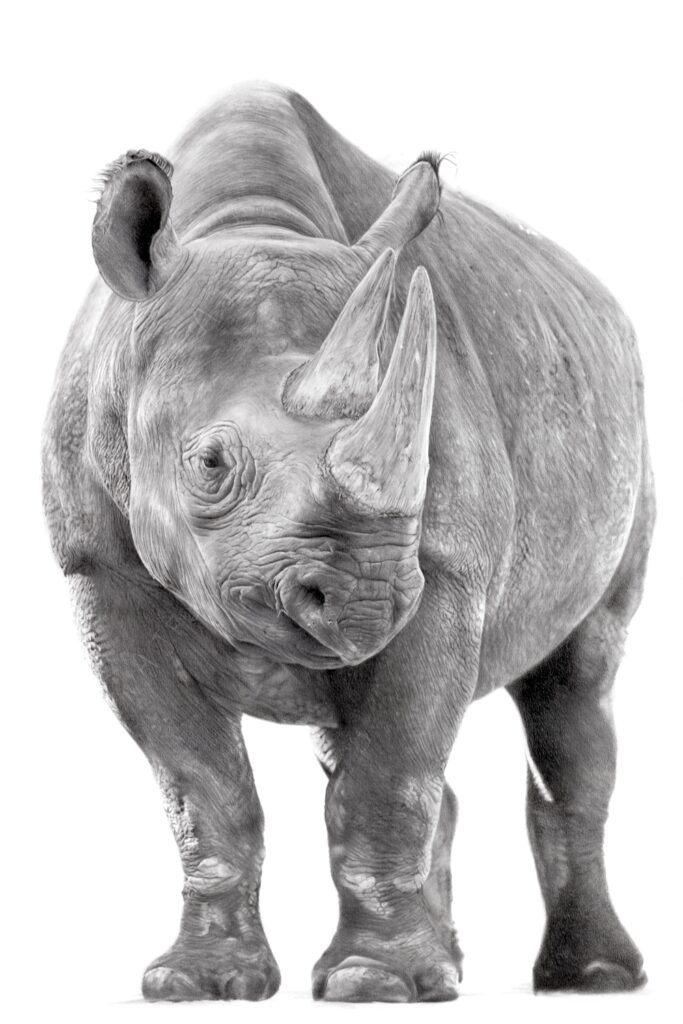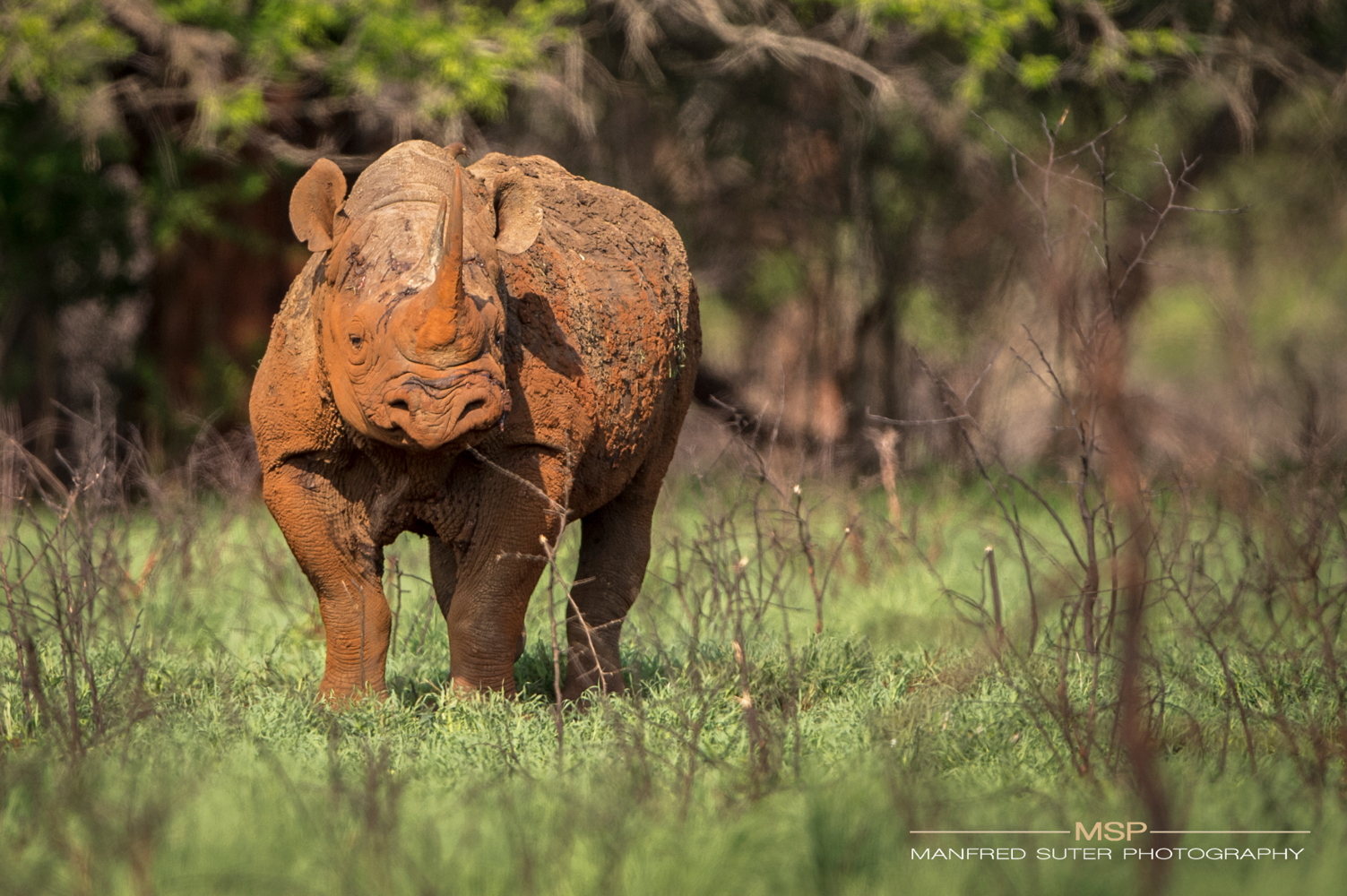I am taking part in the Art for Rhinos (Facebook/Instagram) online fundraiser supported by Save The Rhino International.
This is a charity I’ve been donating to for a little while already, but I jumped at the chance to do a little more here! As I hear more reports of poaching and animal trafficking because of the scarcity of and heightened demand for a species, it presents as quite a frightening framework to combat, but one that needs addressing very quickly.
I am donating 50% (£35) from each of the next five “Large” sized “Black Rhinoceros” prints to the Art for Rhinos project, until the middle of June.
Shipping is from the UK, to the UK (£5), EU is void, Rest of World £20-£22.50.
At the time of writing, one print has been sold already. If you’d like to make a real difference to the plight of rhinos in South Africa through helping fund the Anti-Poaching K9 Unit at HiP, and own a genuine reproduction of one of my DSWF Wildlife Artist of the Year 2022 entrants, fit to last you a lifetime, don’t hesitate to follow the above link, or contact me however you like.
I’m very, very proud to have joined a group of exceptional and renowned artists, who are in turn driving donations through their own art sales. Just follow Art for Rhinos (Facebook/Instagram) if you’d like to see what else is available.

*****
The Current Situation
Since 1 January 2022, 96 rhinos have been killed by poachers in Hluhluwe-iMfolozi (HiP) Park in KwaZulu-Natal, South Africa. This compares to 102 in the whole of KwaZulu-Natal in 2021! Since Kruger National Park introduced dehorning in 2019 pressure has intensified in HiP.
The Anti-Poaching K9 Unit at HiP currently has 3 anti-poaching dogs, but not enough handlers to maximise the potential of the unit. The use of dogs in the fight against poaching has been a huge success story. They have proved to be an essential tool in fighting wildlife crime by tracking down poachers, detecting wildlife products and recovering illegal weapons and ammunition. A well-trained ranger alongside a well-trained dog a makes a formidable team.
Art for Rhinos has been set up to raise money to train another handler (R42,000) and to cover their salary for at least a year (R132,000). The HiP K9 unit was set up in 2019 and has already had considerable successes resulting in a number of prosecutions.
All money is being donated via Save the Rhino International who already support HiP as one of their many projects around the world.
Please follow Art for Rhinos (Facebook/Instagram) and #artforrhinos to see all the amazing artists taking part in this fundraiser which will run until mid-June.
Extra Facts
HiP is a public park and is the oldest proclaimed nature reserve in Africa. It has been very badly hit by Covid and the lack of tourism during that time.
***
HiP is renowned worldwide for being the historical home of the Southern white rhino, following the successful ‘Operation Rhino’ efforts in the 1950s to bring back White rhino from the brink of extinction.
***
Black rhino are classed as Critically Endangered. White rhino are classed as Near Threatened.
***
Kwa-Zulu Natal has the greatest density of rhino in South Africa, and Hluhluwe-iMfolozi Park is home to an incredibly important population of both white and black rhino.
Hluhluwe-iMfolozi Park’s rhinos’ biggest threat is from poaching for the international illegal trade in rhino horn. While poaching pressure remains intense in Kruger National Park, there has been a shift towards other provinces, with KwaZulu-Natal, and Hluhluwe-iMfolozi Park in particular, suffering from the changing pattern of poaching.
The poaching intensity has been truly high. During this time, aviation support, the K9 units, and field ranger teams having been working extremely hard under challenging circumstances to carry out anti-poaching and monitoring activities.
***
Due to increasing intensity of poaching in Hluhluwe-iMfolozi Park, field rangers have been stepping up their monitoring and patrolling efforts in the area. Tracking dogs from the K9 Unit have been helping to track and deter suspected poachers. It is clear that without the dedication and hard work of the staff in Hluhluwe-iMfolozi Park the numbers of rhinos being poached would be much higher.
The Park plays an important role in growing South Africa’s Black rhino population, with Black rhino translocated from the park to other areas through the Black Rhino Range Expansion Programme.
***
In Africa, the White rhino population, under pressure from poaching, is declining. The official current Southern white rhino population estimate from IUCN’s African Rhino Specialist Group is around 18,000 White rhino – but this is a 12% decrease for this species in the past decade.
In Kruger National Park – once thought to be the largest population of White rhinos in the world – White rhino had plummeted 67% from about 10,621 in 2011 to just 3,549 individuals in 2019. And now poachers have turned their attention to Hluhluwe-iMfolozi Park as Kruger started dehorning their rhino in 2019.
Still recovering from devastating poaching losses since the 1970’s, Africa’s other species, the Black rhino, has seen an encouraging population increase of 16-17% over the past decade. Though the species remains Critically Endangered, the population has increased to around 5,600.
***
Operation Rhino has its roots in the Hluhluwe-iMfolozi Park. Initiated in the 1960s, the project aims at spreading rhinos from the Park to other protected areas and privately owned land in order to promote an increase in the population of these iconic and threatened animals. With rhinos in the park threatened, it not only affects the local population, but has far reaching consequences throughout Africa.
***
Traditional Chinese Medicine: poaching pressure escalated during the 1970s and 1980s as a result of the rising demand for rhino horn in Asia and the Middle East. Between 1970 and 1992, the Black rhino suffered a 96% reduction in numbers, with total numbers dipping as low as around 2,400
Black Rhino Current threat: Poaching remains the biggest threat to Black rhinos.
*****
Interesting Rhino Facts
Black Rhino physical characteristics – more details here.
- Weight: adult males weigh up to 1,350 kg and females up to 900 kg. Weight at birth: 35-45 kg
- Shoulder height: Black rhinos stand at approximately 1.6 metres tall at the shoulder
- Skin colour: there is actually no colour difference between the White and Black rhino. They are both of a dark grey colour, but this can vary depending on local soil conditions (as rhinos tend to wallow in the mud or dust, their skin may vary in colour accordingly)
- Hair: they only have hair on the ears, tail tips and eyelashes
- The horn: Black rhinos have two horns, which grow continually from the skin at their base throughout their life (like human fingernails). Rhinos from different areas can have horns of different shapes and sizes also vary. The shape of the horn also differs between sexes: with males tending to have thicker horns, and the females often longer and thinner ones. The horn is comprised of thousands of compressed hair-like strands of keratin (like hair and fingernail fibres), making it extremely hard and tough, but it can be broken or split during fighting. The front (anterior) horn is longer than the rear (posterior) horn, averaging at around 50 cm long
- Distinctive characteristics: Black rhinos are smaller than White rhinos, and have less of a pronounced hump on the back of their necks. They also have a smaller head, as unlike the white rhino, they are browsers, so eat from higher bushes or trees, requiring less muscle strength around their necks than White rhinos. The most distinguishable characteristic between a black and a white rhino is that Black rhinos have a hooked lip, as opposed to a flat-based lip, which is related to their eating habits
- Gestation and birth: females will reach sexual maturity and may have their first calf at 3.5-4 years old. The gestation period of a black rhino is 15-17 months and when a female is preparing to calve, she will find a solitary, sheltered spot to give birth
- Calves: at birth, calves can weigh around 30-45 kg, and can usually stand within the first few hours after being born. They will suckle for the first two months of life, when weaning usually occurs, but may sometimes continue suckling for up to a year. Black rhino calves stay with their mother for 2-4 years before being rejected, usually when the female is ready to calve again. After a newborn calve is around 6-8 months old, a female may allow a previous calf to rejoin her, although these have normally established their own territory by this point
- Food: black rhino are browsers, ie they eat trees, bushes and shrubs. When they bite off woody plant parts they often leave a clean-angled (pruning-shear type) edge (elephant tend to shred the ends of branches like a toothbrush), achieved by the shape of their hooked lip. This neatly bitten, woody material can be clearly seen in the traces of their dung
- Senses: Black rhinos have poor eyesight, and cannot easily detect an observer standing more than 30 metres away. They do however have an excellent sense of smell and hearing
- Running speed: Black rhino can move extremely fast and have been recorded at highs of 55 km/h. They can change direction surprisingly quickly and can run right through scrub and bushes
- Longevity: black rhinos live up to 30-35 years in the wild and 35-45+ years in captivity
- Friendly relations: red and yellow-billed ox-peckers are often seen with rhino and benefit them by removing ticks and clearing parasites from any open wounds, and also by raising the alarm if there is any danger approaching
White rhino physical characteristics – more details here.
- Size: the White rhino is the larger of the two African species. It has a bigger head, due to the muscles that support its neck, as the animal feeds from the ground with its head lowered for much of the day
- Weight: adult males weigh between 1,800 and 2,500 kg and females 1,800-2,000 kg
- Weight at birth: 40-60 kg
- Shoulder height: 1.5-1.8 m
- Skin colour: the colour of their skin is grey. There is no difference in the skin colour of White and Black rhinos, despite their names
- Hair: White rhinos have hair only on ears, tail tips and eyelashes
- Distinctive characteristics: their outline is characterised by a pronounced hump. The head hangs down, low to the ground; they look up only when alarmed. White rhinos have two horns on the end of their nose. The front horn is usually much larger than the inner horn. Rhinos are known for their distinct ‘prehistoric’, solid look; an appropriate labelling for one of the oldest land mammal species in the world
- Sounds and calls: White rhinos can communicate vocally, using a wide range of sounds from calf squeaking to snarling or wailing of adults
- Gestation and birth: White rhino have a gestation period of approximately 16 months. Females usually give birth for the first time at the age of 6.5-7 years. The interval between calving is 3-4 years. Pregnant females will leave their crash shortly before the parturition and stay apart for several days afterwards. Calves stand up within one hour, immediately attempting to suckle. Mother and calf become inseparable; the calf usually moves in front of its mother and immediately responds to the mother’s behaviour. The calf begins grazing at two months, weaning occurs at around one year of age. The calf stays with mother for around three years
- Daily Activity: White rhinoceroses feed and rest alternately during day and night. In hot, dry weather they routinely rest during the hottest part of the day. Much of their resting time is spent wallowing to keep cool and to get rid of skin parasites. They need water for drinking every 2-4 days. If there is no wallowing place available, they will roll in dry dust
- Behaviour: rhinos tend to wallow in the mud, which serves as a cooling technique, effective sun protection and insect repellent. After wallowing, the visual colour of the animal inevitably matches the colour of the local soil
- Running speed: White rhinos are surprisingly agile and can run very fast, up to 40 km/h for short periods
- Senses: they have poor eyesight, but acute senses of hearing and smell
- The horn: horns are used as weapons against predators and for dominance and threat displays in contact with other rhinos. White rhinos have two horns: The Southern White rhino’s horn can reach 79″; while the smaller rear (posterior) horn reaches up to around 22″. As with all rhino species, the horns grow from the skin and consist of compressed strands of keratin (like fingernail fibres). They are not attached to the skull, but rest on bone pedicels at its dorsal part. The horns are continuously growing and if broken away, will subsequently grow back
- Longevity: they live up to 50 years
- Sexual maturity: males 10-12 years, females 6-7 years. Intervals between calving for one female is usually between 3-4 years
- Food: White rhinos feed on grasses and their broad upper lip is adjusted to this type of food (hence the synonym square-lipped)
The illegal trade of rhino horn has been ongoing for decades. Populations of white and black rhino have seen a grave decline as a result. If you’d like to make a real difference to the HiP Anti-Poaching Unit, please purchase one of my “large” prints, or you can donate directly to Save The Rhino International.
Thank you 🙂





Recent Comments